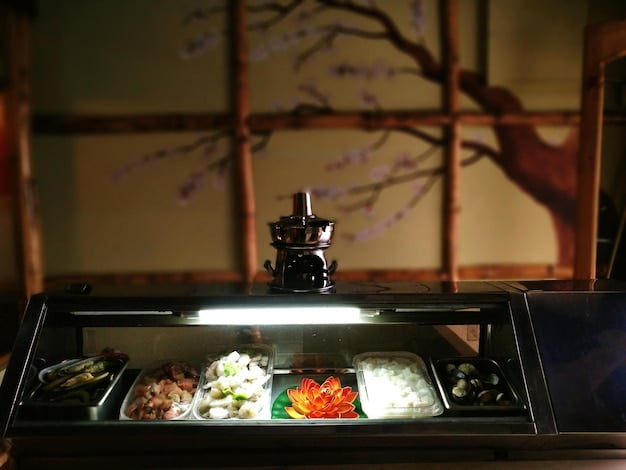The Impact of Korean Dramas on US Viewers: A Cultural Study

The Impact of Korean Dramas on US Viewers: A Study of Cultural Influence reveals a significant shift in cultural consumption, demonstrating how K-dramas have fostered increased interest in Korean culture, language, and cuisine among American audiences, while also impacting fashion and beauty trends.
The rise of Korean dramas, or K-dramas, in the United States is more than just a fleeting trend; it represents a significant cultural phenomenon. This article delves into The Impact of Korean Dramas on US Viewers: A Study of Cultural Influence, exploring how these captivating narratives have reshaped American viewers’ perceptions and interests.
The K-Drama Wave: An Introduction
Korean dramas have swept across the globe, and the United States is no exception. What began as a niche interest has blossomed into a mainstream obsession, influencing everything from fashion choices to culinary preferences. Let’s examine the journey of K-dramas in the US and their profound cultural impact.
The Initial Spark: K-Dramas Enter the US Market
The introduction of K-dramas to the US market wasn’t sudden. Early exposure came through Korean-American communities and niche online platforms. As streaming services expanded, so did the accessibility of these shows.
Streaming Services: A Game Changer
Platforms like Netflix, Hulu, and Viki have played a pivotal role in popularizing K-dramas. Their curated selections and multilingual subtitles made these shows accessible to a broad audience.
- Accessibility: Streaming services broke down language barriers.
- Variety: A diverse range of genres, from romance to historical dramas.
- Convenience: On-demand viewing catered to modern lifestyles.
The growing availability of K-dramas transformed them from a niche interest into a widespread cultural phenomenon.

Cultural Exchange: Beyond Entertainment
K-dramas offer more than just entertainment; they serve as a gateway to Korean culture. The impact extends to language learning, cuisine exploration, and even travel aspirations.
Language and Learning
Many viewers find themselves drawn to the Korean language after watching K-dramas. Common phrases and expressions become familiar, sparking an interest in formal language study.
Food, Fashion, and Beauty Trends
The impact of K-dramas extends beyond language, influencing everyday lifestyle choices. Food, fashion, and beauty trends showcased in the shows often find their way into the American mainstream.
- Kimchi Craze: Korean cuisine gains popularity.
- Fashion Inspiration: Styles from K-dramas influence clothing choices.
- Beauty Products: Korean skincare routines become highly sought after.
Travel Aspirations
The scenic landscapes and cultural sites featured in K-dramas inspire wanderlust. Americans are increasingly adding South Korea to their travel bucket lists.
K-dramas act as cultural ambassadors, creating interest and driving tangible changes in hobbies, interests and even the travel opportunities that US viewers want to experience.
The Appeal of K-Dramas: Why They Resonate
The success of K-dramas in the US boils down to several factors. Compelling storylines, high production values, and a unique storytelling approach all contribute to their appeal.
Compelling Storylines and Character Development
K-dramas often feature intricate plots, well-developed characters, and emotional depth. These elements keep viewers engaged and invested in the story.
High Production Values
The quality of production in K-dramas has steadily improved over the years. High-definition visuals and captivating soundtracks enhance the viewing experience.
Unique Storytelling Approaches
K-dramas often employ storytelling techniques that differ from Western television. Elements like cliffhangers and sentimental themes resonate with a wide audience.
These elements combine to form a captivating viewing experience, drawing viewers into the world of K-dramas and keeping them hooked on the stories being told.
Changing Perceptions: Breaking Stereotypes
K-dramas have the power to challenge and change perceptions. By showcasing modern Korean society and culture, they help break down stereotypes and foster greater understanding.
Showcasing Modern Korean Society
K-dramas offer a glimpse into modern Korean life, highlighting the country’s technological advancements, vibrant cities, and diverse population.
Challenging Stereotypes
By presenting nuanced characters and complex narratives, K-dramas challenge preconceived notions about Korean people and culture, leading to a more informed and empathetic understanding.
Fostering Global Understanding
The cultural exchange facilitated by K-dramas transcends entertainment. It fosters cross-cultural dialogue and promotes mutual respect.

The Role of Social Media: Amplifying the Impact
Social media platforms play a crucial role in amplifying the impact of K-dramas. Online communities, fan pages, and viral trends contribute to the widespread popularity of these shows.
Online Communities and Fan Pages
Dedicated online communities and fan pages provide spaces for viewers to connect, discuss their favorite shows, and share their passion for K-dramas. The level of conversation and involvement is very high thanks to passionate fans.
Viral Trends and Challenges
K-dramas often spark viral trends and challenges on platforms like TikTok and Instagram. These trends further expose the shows to new audiences.
The Power of Word-of-Mouth
Social media facilitates word-of-mouth marketing, as viewers share their recommendations and reviews with their online networks. This organic promotion is invaluable for expanding the reach of K-dramas.
Social media has been pivotal in making K-dramas much more popular in the US, thanks to online communities that actively endorse the shows.
Criticisms and Concerns: A Balanced Perspective
While the impact of K-dramas is largely positive, it’s important to acknowledge the criticisms and concerns that have been raised. Issues such as cultural appropriation and unrealistic portrayals warrant consideration.
Cultural Appropriation
Some critics argue that certain aspects of K-dramas may constitute cultural appropriation, particularly when they borrow from other cultures without proper understanding or respect. This concern, while not always prevalent, deserves attention.
Unrealistic Portrayals
Another common criticism is that K-dramas often present an unrealistic view of Korean society. Idealized characters and exaggerated scenarios can create a distorted impression, though many find this part of the entertainment value.
Addictive Viewing
The binge-watching nature of K-dramas can lead to excessive viewing habits. It’s important for viewers to maintain a balanced approach and avoid neglecting other responsibilities.
While the impact of K-dramas is undeniable, critical assessment is essential for a balanced and informed perspective.
Future Trends: The Evolving Landscape
The popularity of K-dramas in the US is likely to continue growing. Future trends point toward greater localization, expanded genres, and increased collaboration between Korean and American creators.
Greater Localization
As K-dramas become more mainstream, there’s a growing demand for localized content that resonates with American audiences. This may involve adaptations or remakes of popular K-dramas.
Expanded Genres
While romance and family dramas remain popular, there’s potential for K-dramas to explore new genres and themes. Action, science fiction, and thrillers could attract a wider viewership.
Increased Collaboration
Collaborations between Korean and American creators could lead to innovative projects that blend the best of both worlds. These partnerships could result in unique and compelling storytelling.
The future of K-dramas in the US is bright, with opportunities for growth, innovation, and greater cultural exchange.
| Key Point | Brief Description |
|---|---|
| 🎬 K-Drama Popularity | Rise in US viewership due to streaming platforms. |
| 🍜 Cultural Influence | Increased interest in Korean language, food, and fashion. |
| 🤝 Social Media | Online communities amplify K-drama visibility. |
| 🌍 Global Understanding | K-dramas foster cross-cultural dialogue and change stereotypes. |
Frequently Asked Questions
▼
K-dramas resonate due to compelling storylines, high production values, and unique storytelling styles. Streaming platforms also provide easy access to a wide range of K-dramas with subtitles.
▼
They’ve spurred interest in Korean language learning, cuisine, and fashion. Korean skincare routines and beauty products have also become popular, influencing trends and consumer choices.
▼
Social media amplifies K-drama visibility through online communities, fan pages, and viral trends. Word-of-mouth marketing on platforms like TikTok and Instagram drives viewership.
▼
Yes, some argue aspects can represent cultural appropriation & some find that the programs portray an unrealistic view of Korean society. Also, addictive viewing habits could pose a concern for viewers.
▼
Future trends suggest greater localization of content, expanded genres like action and sci-fi, and increased collaboration between Korean and American creators to blend the best of both cultures.
Conclusion
In conclusion, the impact of Korean dramas on US viewers is undeniable, reflecting a cultural shift that celebrates diversity, fosters understanding, and influences various aspects of American life, from entertainment to lifestyle choices. As K-dramas continue to evolve, their influence on the US audience will likely deepen, paving the way for greater cultural exchange and collaboration.





